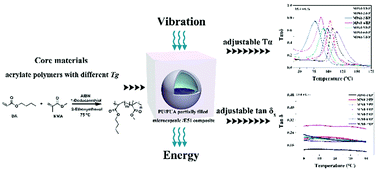Effect of microcapsules partially filled with viscoelastic acrylate polymer on damping behaviours of epoxy resin†
Abstract
This paper presents a discussion of the vibration damping enhancement offered by using composites made of partially filled poly(urethane)/polyurea (PU/PUA) microcapsules and E51 epoxy resin (EP). Seven types of microcapsule (with a core mass fraction of about 60 wt%) were prepared in which the core materials were acrylate polymers with different glass transition temperature (Tg, −53.59 °C to 34.40 °C). Dynamic mechanical analysis measurements were performed to investigate the dynamic mechanical properties of the composites, such as storage modulus E′ and loss factor tan δ. The correlations between the dynamic mechanical properties and the Tg of the core material of the partially filled microcapsules were studied. The microcapsule concentration of 15.4 wt% was found to be more efficient in adjusting the tan δ and the Tα of the E51 epoxy. The MP60-4/EP composite reached the highest tan δmax value of 0.82. By controlling the Tg of the core material, the tan δ of composites at the low temperature region increased from 0.12 to 0.29 and the Tα ranged from 77.1 °C to 114.8 °C.



 Please wait while we load your content...
Please wait while we load your content...